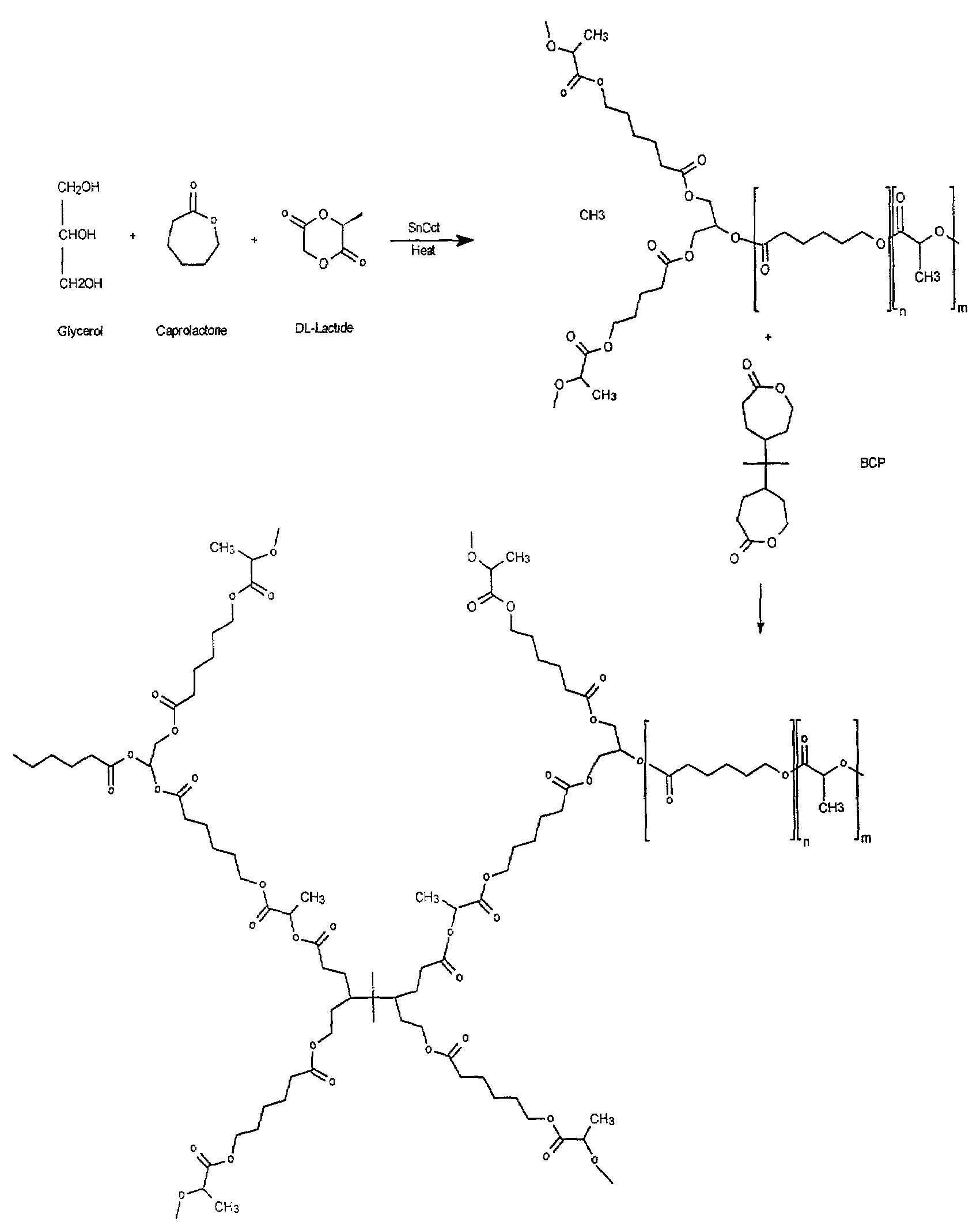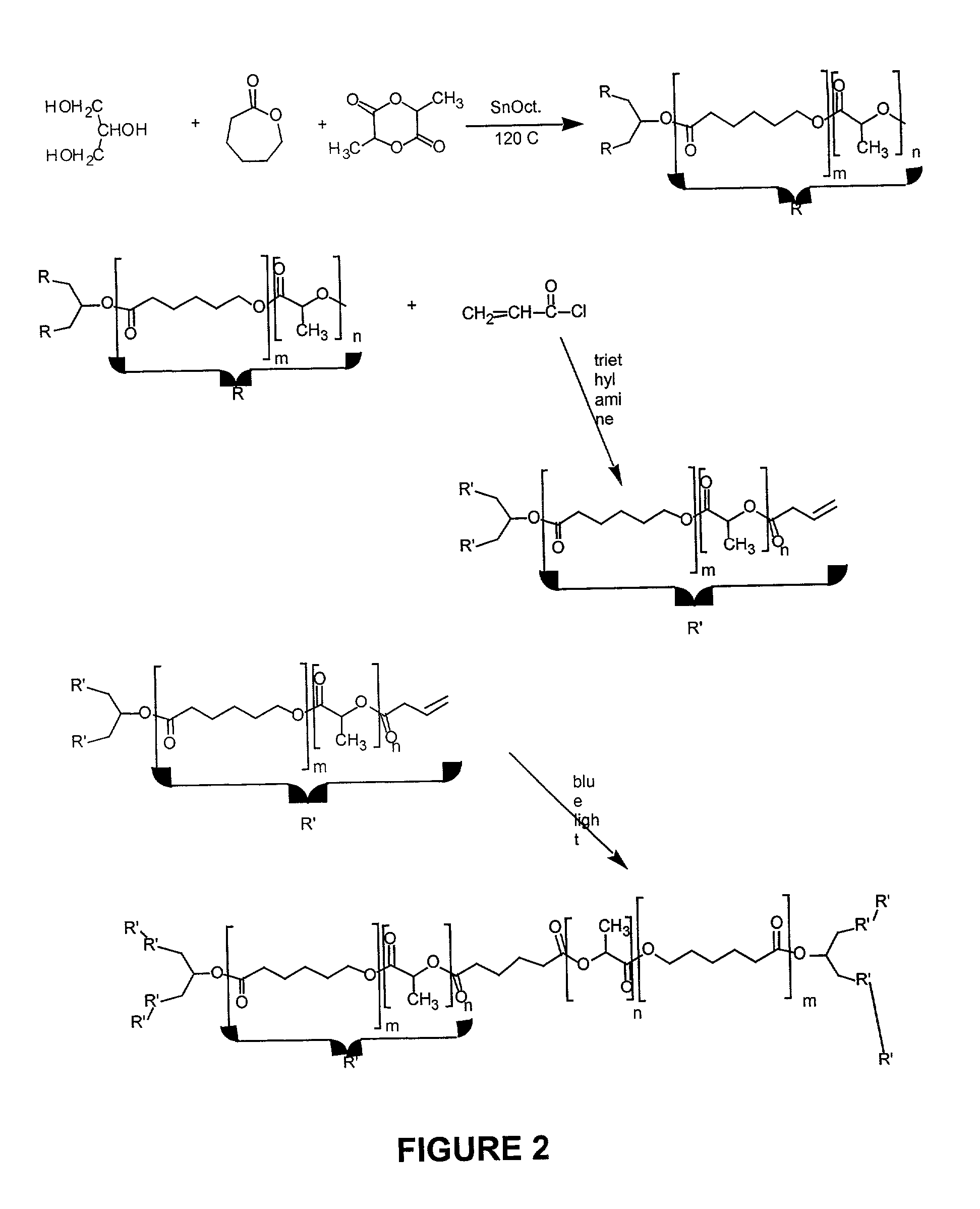Biodegradable elastomer and method of preparing same
a technology of biodegradable elastomers and elastomers, which is applied in the field of biodegradable/biocompatible elastomers, can solve the problems of residual solvents jeopardizing the biocompatibility of materials, degrading to potentially toxic compounds, and difficult reproducibility of physical properties and degradation kinetics of elastomers
- Summary
- Abstract
- Description
- Claims
- Application Information
AI Technical Summary
Benefits of technology
Problems solved by technology
Method used
Image
Examples
working examples
Example 1
Thermally Crosslinked Elastomer
[0054]A rubbery polymer was made by first preparing a star co-polymer composed of D,L-lactide and ε-caprolactone. This co-polymer was crosslinked using a synthesized difunctional bis-ε-caprolactone (see FIG. 1). The procedures for each process are outlined below.
Preparation of Poly(star-D,L Lactide-co-ε-capolactone) (SCP)
[0055]Pure D,L-lactide (DLL or DL) from PURAG was used as received, and ε-caprolactone (ε-CL or CL) from Lancaster was purified by distillation under reduced pressure in the presence of CaH2. Glycerol and stannous octoate from Sigma were used as received.
[0056]Star co-polymers of varying total molecular weight and ε-caprolactone; D,L-lactide monomer ratios were prepared. The preparation conditions are outlined in Table 1. A typical procedure, in which a 50:50 ε-CL:DLL co-polymer is prepared, is given below.
[0057]To a flame dried 20 mL glass ampoule was added 6 g purified ε-caprolactone, 7.6 g D,L-lactide, and 0.48 g glycerol. ...
example 2
Photo-Crosslinked Elastomer
[0063]A reaction scheme for the following method of preparing an elastomer using a photo-crosslinkable polymer is shown in FIG. 2, and procedures are given below.
Preparation of Acrylate Terminated Star Co-polymer
[0064]In a round bottom flask, 10 g of SCP (5×10−3 mole) was dissolved in 100 ml of dichloromethane (DCM) using a magnetic stirrer. The flask was sealed using rubber septum and flushed with argon gas to remove the oxygen. This process was repeated every hour throughout the procedure. The flask was then immersed in an ice bath to drop the temperature of the solution to 0° C. After reaching 0° C., 1.25 ml of acryloyl chloride (ACLR) (0.015 mole), 2 ml of triethylamine (TEA), and 5 mg of dimethyl aminopyridine (DMAP) were added in a step wise manner over a period of 12 hours while the solution was kept at 0° C. The reaction was continued at room temperature for another 12 hours. The reaction completion was detected using TLC plates. The final solution...
example 3
Degradation of Elastomeric Polymer
[0072]The thermoset elastomeric polymers described in Example 1 were tested for in vitro degradation rates in pH 7.4 phosphate buffered saline under gentle agitation. Results are shown in Table 3 and FIGS. 8 to 10.
[0073]Tensile properties (extension ratio. Young's Modulus, and ultimate tensile strength) of the elastomer were measured over an eight week period of degradation. Tensile properties were obtained at each time point of FIGS. 8 to 10 using an Instron model 4443 tensile tester (Instron Corporation, Canton, Mass.) equipped with an elastomeric extensometer, and using a crosshead speed of 50 cm / minute, as per ASTM 412. Each sample was pre-fabricated into strips about 7.5 cm×6 mm×3 mm. Each data point in the figures represents the average of from 3 to 5 samples and the error bars represent standard deviation.
[0074]Table 3 shows the mean percentage increase in weight of these elastomers over a twelve week period.
[0075]
TABLE 3Mean percentage Incre...
PUM
| Property | Measurement | Unit |
|---|---|---|
| Temperature | aaaaa | aaaaa |
| Temperature | aaaaa | aaaaa |
| Pressure | aaaaa | aaaaa |
Abstract
Description
Claims
Application Information
 Login to View More
Login to View More - R&D
- Intellectual Property
- Life Sciences
- Materials
- Tech Scout
- Unparalleled Data Quality
- Higher Quality Content
- 60% Fewer Hallucinations
Browse by: Latest US Patents, China's latest patents, Technical Efficacy Thesaurus, Application Domain, Technology Topic, Popular Technical Reports.
© 2025 PatSnap. All rights reserved.Legal|Privacy policy|Modern Slavery Act Transparency Statement|Sitemap|About US| Contact US: help@patsnap.com



